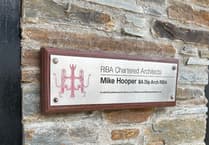AN innovative homeowner has made radical changes to his historic home to beat escalating energy costs.
Adam Simpson and his partner Gemma Williams live in one of the famed Bedford Cottages in Tavistock, dating from the mid 1800s, but are considered by many to be damp and expensive to heat.
However, Adam has thought creatively and scientifically, by going back in time to create possibly one of the most energy efficient and comfortable of the cottages, built by the landowner the Duke of Bedford for his workers as the population boomed.
He has endured three years of a partially complete makeover to remedy the past mistakes of the seventies aimed at curing damp and improving insulation, but only served to hide and worsen the problems which he uncovered during renovation.
Adam said: ‘I love living in older buildings and bought my Bedford Cottage with my heart, but my head soon realised it was not the most rational thing to do. It’s a bit like Grand Designs on the telly where people take on these major projects and end up regretting it. I’ve had my moments, but it’s really rewarding when you can see the black mould and moisture disappear and feel your home drying out and getting warmer, simply by using old methods.’
Adam started on the outside to prevent rain entering by draining off the higher garden path away from the lounge. He dug a ‘French’ drain and filled it with granite chippings.
Inside, he and a neighbour dug up one-foot depth of the lounge floor and filled two skips with earth because it sponged up water making the downstairs constantly damp during the winter.
Adam explained: ‘The house was effectively sitting on granite blocks embedded in damp earth with nothing to stop the damp coming up through the floor.’
The new flooring he laid comprised so-called glasscrete, a breathable version of concrete with crushed aerated glass (in the form of honeycomb) and a geotextile layer. The new floor insulates and does not trap water under the floor to create permanent damp, but allows it to flow beyond the house.
The chimney was removed and rebuilt, capped and sealed after it acted as a hose, channelling rain into the house and the neighbour’s. He reopened the fireplace after it had been blocked off and filled with material which collected water.
Every internal wall had the concrete slurry render and plaster board, with its modern plastic-based paint, removed and the stone brushed with insulating lime and eco-cork render and finished with breathable silica-based paint. The outside walls were also treated with the alternative render and paint.
Adam said: ‘It was incredible seeing the house literally dry out before my eyes and now its also dry, warm and cheaper to heat - all by retaining the character.





Comments
This article has no comments yet. Be the first to leave a comment.